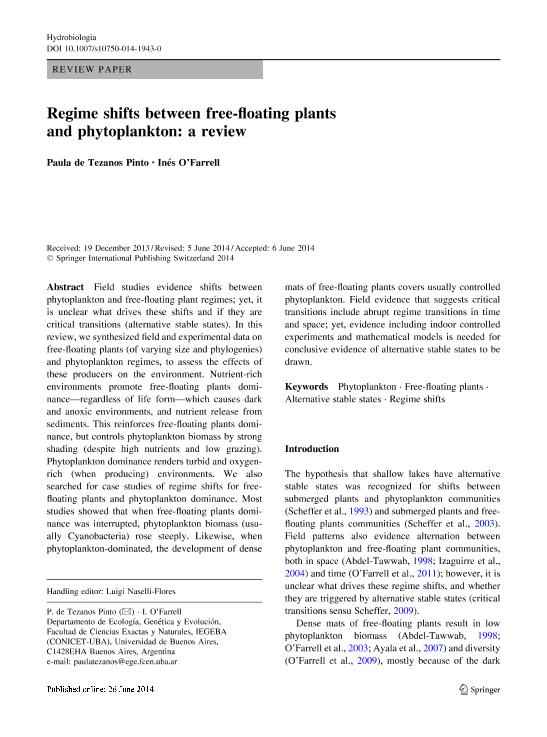Mostrar el registro sencillo del ítem
dc.contributor.author
de Tezanos Pinto, Paula

dc.contributor.author
O'farrell, Ines

dc.date.available
2017-07-05T18:55:52Z
dc.date.issued
2014-11
dc.identifier.citation
de Tezanos Pinto, Paula; O'farrell, Ines; Regime shifts between free-floating plants and phytoplankton: a review; Springer; Hydrobiologia; 740; 1; 11-2014; 13-24
dc.identifier.issn
0018-8158
dc.identifier.uri
http://hdl.handle.net/11336/19627
dc.description.abstract
Field studies evidence shifts between phytoplankton and free-floating plant regimes; yet, it is unclear what drives these shifts and if they are critical transitions (alternative stable states). In this review, we synthesized field and experimental data on free-floating plants (of varying size and phylogenies) and phytoplankton regimes, to assess the effects of these producers on the environment. Nutrient-rich environments promote free-floating plants dominance—regardless of life form—which causes dark and anoxic environments, and nutrient release from sediments. This reinforces free-floating plants dominance, but controls phytoplankton biomass by strong shading (despite high nutrients and low grazing). Phytoplankton dominance renders turbid and oxygen-rich (when producing) environments. We also searched for case studies of regime shifts for free-floating plants and phytoplankton dominance. Most studies showed that when free-floating plants dominance was interrupted, phytoplankton biomass (usually Cyanobacteria) rose steeply. Likewise, when phytoplankton-dominated, the development of dense mats of free-floating plants covers usually controlled phytoplankton. Field evidence that suggests critical transitions include abrupt regime transitions in time and space; yet, evidence including indoor controlled experiments and mathematical models is needed for conclusive evidence of alternative stable states to be drawn.
dc.format
application/pdf
dc.language.iso
eng
dc.publisher
Springer

dc.rights
info:eu-repo/semantics/openAccess
dc.rights.uri
https://creativecommons.org/licenses/by-nc-sa/2.5/ar/
dc.subject
Regime Shifts
dc.subject
Phytoplankton
dc.subject
Free Floating Plants
dc.subject
Alternative Stable States
dc.subject.classification
Ecología

dc.subject.classification
Ciencias Biológicas

dc.subject.classification
CIENCIAS NATURALES Y EXACTAS

dc.title
Regime shifts between free-floating plants and phytoplankton: a review
dc.type
info:eu-repo/semantics/article
dc.type
info:ar-repo/semantics/artículo
dc.type
info:eu-repo/semantics/publishedVersion
dc.date.updated
2017-07-05T15:04:21Z
dc.identifier.eissn
1573-5117
dc.journal.volume
740
dc.journal.number
1
dc.journal.pagination
13-24
dc.journal.pais
Alemania

dc.description.fil
Fil: de Tezanos Pinto, Paula. Consejo Nacional de Investigaciones Científicas y Técnicas. Oficina de Coordinación Administrativa Ciudad Universitaria. Instituto de Ecología, Genética y Evolución de Buenos Aires. Universidad de Buenos Aires. Facultad de Ciencias Exactas y Naturales. Instituto de Ecología, Genética y Evolución de Buenos Aires; Argentina
dc.description.fil
Fil: O'farrell, Ines. Consejo Nacional de Investigaciones Científicas y Técnicas. Oficina de Coordinación Administrativa Ciudad Universitaria. Instituto de Ecología, Genética y Evolución de Buenos Aires. Universidad de Buenos Aires. Facultad de Ciencias Exactas y Naturales. Instituto de Ecología, Genética y Evolución de Buenos Aires; Argentina
dc.journal.title
Hydrobiologia

dc.relation.alternativeid
info:eu-repo/semantics/altIdentifier/doi/http://dx.doi.org/10.1007/s10750-014-1943-0
dc.relation.alternativeid
info:eu-repo/semantics/altIdentifier/url/https://link.springer.com/article/10.1007%2Fs10750-014-1943-0
Archivos asociados
